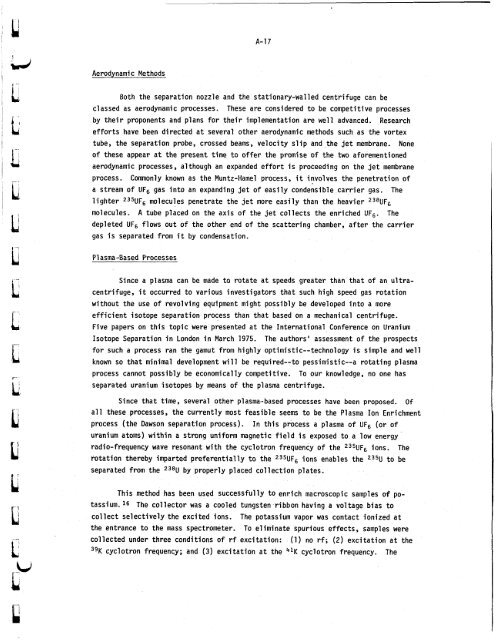ORNL-5388 - the Molten Salt Energy Technologies Web Site
ORNL-5388 - the Molten Salt Energy Technologies Web Site
ORNL-5388 - the Molten Salt Energy Technologies Web Site
Create successful ePaper yourself
Turn your PDF publications into a flip-book with our unique Google optimized e-Paper software.
u A-1<br />
Aerodynamic Methods<br />
7<br />
Both <strong>the</strong> separation nozzle and <strong>the</strong> stationary-walled centrifuge can be<br />
classed as aerodynamic processes. These are considered to be competitive processes<br />
by <strong>the</strong>ir proponents and plans for <strong>the</strong>ir implementation are well advanced. Research<br />
efforts have been directed at several o<strong>the</strong>r aerodynamic methods such as <strong>the</strong> vortex<br />
tube, <strong>the</strong> separation probe, crossed beams, velocity slip and <strong>the</strong> jet membrane. None<br />
of <strong>the</strong>se appear at <strong>the</strong> present time to offer <strong>the</strong> promise of <strong>the</strong> two aforementioned<br />
aerodynamic processes, although an expanded effort is proceeding on <strong>the</strong> jet membrane<br />
process.<br />
Commonly known as <strong>the</strong> Muntz-Hamel process, it involves <strong>the</strong> penetration of<br />
a stream of UF6 gas into an expanding jet of easily condensible carrier gas. The<br />
lighter 235UF6 molecules penetrate <strong>the</strong> jet more easily than <strong>the</strong> heavier 238UF6<br />
molecules. A tube placed on <strong>the</strong> axis of <strong>the</strong> jet collects <strong>the</strong> enriched UF6.<br />
depleted UF6 flows out of <strong>the</strong> o<strong>the</strong>r end of <strong>the</strong> scattering chamber, after <strong>the</strong> carrier<br />
gas is separated from it by condensation.<br />
Plasma-Based Processes<br />
Since a plasma can be made to rotate at speeds greater than that of an ultra-<br />
centrifuge, it occurred to various investigators that such high speed gas rotation<br />
without <strong>the</strong> use of revolving equipment might possibly be developed into a more<br />
efficient isotope separation process than that based on a mechanical centrifuge.<br />
Five papers on this topic were presented at <strong>the</strong> International Conference on Uranium<br />
Isotope Separation in London in March 1975. The authors’ assessment of <strong>the</strong> prospects<br />
for such a process ran <strong>the</strong> gamut from highly optimistic--technology is simple and well<br />
known so that minimal development will be required--to pessimistic--a rotating plasma<br />
process cannot possibly be economically competitive.<br />
separated uranium isotopes by means of <strong>the</strong> plasma centrifuge.<br />
The<br />
To our knowledge, no one has<br />
Since that time, several o<strong>the</strong>r plasma-based processes have been proposed.<br />
all <strong>the</strong>se processes, <strong>the</strong> currently most feasible seems to be <strong>the</strong> Plasma Ion Enrichment<br />
process (<strong>the</strong> Dawson separation process). In this process a plasma of uF6 (or of<br />
uranium atoms) within a strong uniform magnetic field is exposed to a low energy<br />
radio-frequency wave resonant with <strong>the</strong> cyclotron frequency of <strong>the</strong> 235UF6 ions. The<br />
rotation <strong>the</strong>reby imparted preferentially to <strong>the</strong> 235UF6 ions enables <strong>the</strong> 235U to be<br />
separated from <strong>the</strong> 238U by properly placed collection plates.<br />
tassium.<br />
This method has been used successfully to enrich macroscopic samples of po-<br />
The collector was a cooled tungsten ribbon having a voltage bias to<br />
collect selectively <strong>the</strong> excited ions. The potassium vapor was contact ionized at<br />
<strong>the</strong> entrance to <strong>the</strong> mass spectrometer. To eliminate spurious effects, samples were<br />
collected under three conditions of rf excitation: (1) no rf; (2) excitation at <strong>the</strong><br />
39K cyclotron frequency; and (3) excitation at <strong>the</strong> 41K cyclotron frequency. The<br />
Of



![Review of Molten Salt Reactor Physics Calculations [Disc 2]](https://img.yumpu.com/21979492/1/190x247/review-of-molten-salt-reactor-physics-calculations-disc-2.jpg?quality=85)












